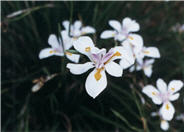
Common name:Snow-In-Summer
Botanical name:Cerastium tomentosum
Masses of snow white flowers highlight this plant during the early summer season. This attractive ground cover is a great filler among other plants and rocks. Foliage is silver gray or gray/green and is woolly. This plant tolerates coastal conditions and desert areas. Use in rock settings, in hanging baskets, containers, or as a lawn substitute. Cut back in fall to refresh plant.

Common name:Victor Reiter Thyme
Botanical name:Thymus 'Victor Reiter'
This evergreen ground cover needs full sun to light shade. It grows to 3" tall, forming a dense, thick mat. It needs well-drained, light soil. This thyme is considered drought tolerant. The foliage is dark green and slightly hairy. It has a pleasant, minty fragrance when crushed, though not considered for culinary uses. Flowers are lilac purple and bloom in the summer. It attracts bees and butterflies.

Common name:Yellow Dietes or Fortnight Lily
Botanical name:Dietes bicolor
This clumping perennial iris relative stands 3'-4' high. It has light- yellow, iris-like flowers with maroon blotches that are about 2" wide. It performs best in full sun and in soil with good drainage.

Common name:Blue Fescue, Blue Fescue Grass
Botanical name:Festuca glauca
This ground cover/grass will grow less than 1' tall and has small, blue-green, evergreen leaves that are very thin and hair-like. Flowers appear in the summer but are insignificant. This dependable ground cover prefers full sun in coastal areas and afternoon shade in warm inland areas. It needs well draining soil and is drought tolerant once it's established. Leaves may burn during the summer but trim in winter to keep it looking refreshed.

Common name:Blue-Eyed Grass
Botanical name:Sisyrinchium bellum
Following winter rains, this grassy perennial brings a soft texture back into the garden. It produces an abundance of small blue-purple flowers which have a long bloom. Foliage is similar to Irises. This California native prefers full sun and is drought tolerant once it's established. It's great in small spaces and among rocks. This plant reaches about 1' tall.

Common name:Copper King Gazania
Botanical name:Gazania 'Copper King'
This perennial groundcover will grow 6"-10" tall and has soft, greyish-green foliage with yellow-orange flowers that bloom April to September.

Common name:Butterfly Iris or Fortnight Lily
Botanical name:Dietes iridioides
This clumping evergreen iris bears tall, narrow leaves to 30" tall and white flowers marked purple in the center on stalks to 3' tall, appearing spring through fall. This variety has stiffer, darker foiliage than the bicolor form. It requires sun to part shade with little or no summer watering when established. This is a very reliable plant. Divide every 3-5 years to keep it looking fresh.

Common name:Garden Nasturtium
Botanical name:Tropaeolum majus
This garden annual/groundcover will grow less than 1' tall, but will spread and climb up to 6'. Nasturtium has 2" light green leaves with red, orange, yellow, or white flowers that are in constant bloom throughout the warm season. This plant usually reseeds, with new plants emerging in early spring. This plant does better with regular watering. Some folks put the leaves and flowers in salads!
We can identify at least 11 steps of sustainable landscape renovation for consideration. They include critical design, installation and maintenance practices that conform to good principles of appropriate horticulture.
Click in the green box for more information
If you have impermeable paving that you would like to make permeable, there are two main methods for doing so:
1. Break up hard paved surfaces to create spaces for water to seep through.
2. Remove and replace the surfaces with permeable paving.
Click in the green box for more information
Designer:
Photographer: GardenSoft
Incorporate compost 6" into your soil to retain water, reduce compaction, feed earthworms, and provide valuable nutrients to your plants.
Remove irrigation water and fertilizer from areas where you don't want weeds to grow.